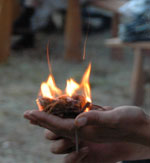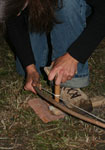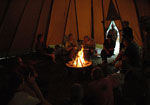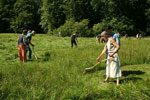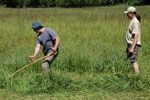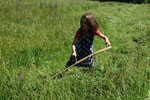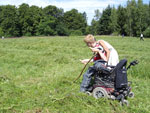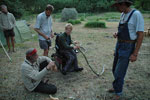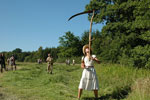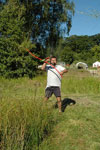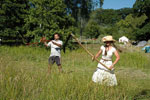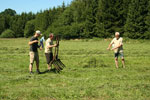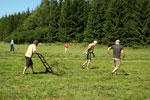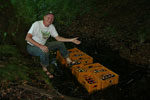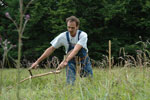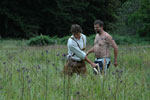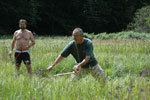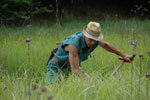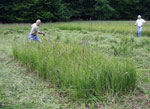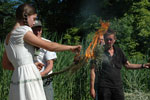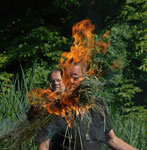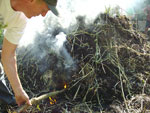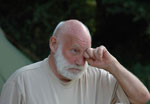
Site Contents
About Us
Contact Us
Events
Products
Scythe Buyers' Guide
Technical/
Instructional
Updates
Video
Home
Gribskov (Denmark) Scythe Festival 2008
--a report by Peter Vido
Yes, we are late, very late. The nicest of all scythe-related events I've ever attended fully deserved a more prompt report on this website. But for anyone who considers organizing a similar gathering next year, there is still time to benefit in some way by reflecting on aspects of the Danish "blueprint".
Many people deserve a special thanks for making this event what it was. Henrik Jørgensen, a conservation biologist and the "Oldermand" of the first Danish scythe association (Strøgårdsvang Høslaetlaug) was the primary mover of the idea. Yet without serious organizational and hands-on help from many other members, none of it would have been possible. As a group they provided visitors with hospitality at its best.
One distinction between this festival and most other open-to-the-public scythe events was the non-electric facilities (food prepared on a wood-burning outdoor cookstove; no glaring lights or plug-in coffee-makers.) Instead of fancy B&B accommodations, most attendees set up tents in the meadow and forest, disregarding the tiny deer ticks (perhaps the most dangerous of wild animals in Denmark). The organizers also provided two 10-metre Sioux-style tipis -- one for general meeting and eating and one as a hotel for visitors without their own tents. The location was within the National Forest of Grib, from which personal automobiles are banned. Ah, so different from a scythe festival next to a busy road or a parking lot full of cars!
Further to my delight, there were no hungry machines gathering the many tons of scythe-cut forage -- as silage -- into ugly plastic bags, disturbing the peace at the end of each day.... (This is a common occurrence at scythe events in other "progressive" countries, where most farmers now feed silage instead of hay to their cows and sheep). Here, the grass was made into hay by a variety of traditional, solely hand-labour methods. By a stroke of luck, we were spared any weather-related anxiety and could work in a relaxed manner. Although it had rained frequently up to the beginning of the festival, the sun gods came to our rescue... with rain resuming the next week.
Another noteworthy distinction: While the central attraction of many scythe festivals are mowing competitions, they did not dominate this one. The focus was decidedly educational, with hands-on aspects outweighing the theory. Two days were slated for courses with 90 signed-up students. Thanks to the generous funding by The Forest and Nature Agency under The Ministry for The Environment, all courses could be held free of charge.
Having fifteen instructors, from six different countries, was also an uncommon occurrence -- even if some students were likely confused by demos of different ways of "skinning a cat" (an English idiom). To the instructors (who, if truth be told, are all still but students) this was potentially very educational. Apart from scheduled sessions, advice on sharpening and mowing was readily available for the asking nearly anytime. An unusual diversity of scythes was seen in action and tried out by all who desired.
The course participant from furthest away was Nicole Schmid, who was might-near ready to swim (but in the end took a plane) all the way from Australia to be there!
To many of us, one of the additional and very fitting bonuses was the well organized step by step demonstration of traditional charcoal making. For several thousand years charcoal, after all, was the fuel of choice for the blacksmiths' craft. Wherever the world's "best ever" scythe blade may now exist, one thing is certain -- it was once forged in a charcoal fire.
The famous Danish Frederiksborg horses also provided a nice touch and a historical connection. Three mares with foals, pastured next to the "hearth" of the event during the whole time, watched as people with scythes and rakes made hay for their winter feed.
An impromptu treat was the presence of Günter Friese, the wood-turning instructor at Dick Feine Werkzeuge in Southern Germany. His old van arrived filled with what Günter refers to as his "forest woodworking shop". Besides a pile of wildwood snath making material, he brought an equally wild spring pole style lathe. With the help of his friend Claudio, they set it up in minutes and demonstrated its usefulness.
The mowing competitions were far more light-hearted than I've witnessed them anywhere else (other than during our 2006 Scythe Symposium in New Brunswick). Modeled after a relatively recent (1998) German "innovation", each team of four mowers had a 8x15 parcel to cover in semi-relay fashion (when the first person is at the halfway mark, the second can begin, and so on). Originally Henrik just wanted to have the Danish quartet mow against Canada. But the international attendance made it possible to also put together a team consisting of two Austrians and two Germans, and another of two Brits, a Swede and a Belgian. Four teams made the whole thing more entertaining.
The likely reason why the Canadians won was because the members of the other teams probably consumed more of the superb micro-brewed ale (kindly donated by Brøckhouse of Hillerød) than they did. (Canada's beer consumption, as you may know, is far below countries like Denmark, etc.) The hosts took it in stride, however, and did not deprive us of their hospitality afterward... which was nice.
But even the Danes could not resist including the somewhat silly, and for entertainment purposes during scythe events nearly everywhere a very popular class: "Scythe versus Machine". The machine in this case was a steel-bladed Husqvarna thinning saw operated by Carsten Carstensen, a husky Dane who earns his living operating it. He wasn't there to please a crowd of scythe-nuts and appeared surprised when he lost (by several seconds). The 100cm long scythe blade was powered by barefooted, fifteen-year-old Ashley Vido. (A bit of trivia: the same blade was used by her sister Fairlight who, at the time also fifteen, competed successfully against another grown man and a similar machine in Nova Scotia, Canada in 2005.)
And although the winning girl earned more applause, the title for this festival's "Most Determined Mower" must go to 14-year-old Andreas Christensen. Confined to a wheelchair due to cerebral palsy, he came with his parents to join the courses. His initial struggle with a conventional scythe made it clear that he needed a very specialized version of the tool. Designing one was a new and interesting challenge, on which we made some progress right then and followed up with a day at Andreas' home later. The result so far is that he now can actually mow grass on his own (though not yet sharpen his blade -- the next aspect to solve). (Note 1)
In a way, this Danish Festival ought to have been called the Third International Scythe Symposium and Festival. Altogether folks from eight countries attended this event -- which is quite remarkable considering that the First International Scythe Symposium and Festival (which took place in Austria in 2004) managed to draw participants from but 10 countries. The Austrian event had a very substantial budget from the EU, was planned more than a year in advance and took place in what has been referred to as "the cradle of the scythe industry".
Photos by: Filip Verhaeghe, Peter Friis Møller, Allan Gudio Nielsen, Freddy Tornberg and Ashley Vido. (Photos were selected from many people's contributions and it would be cumbersome to give individual credit to each.)
Mowing:
 Some of the scythes we had a chance to see and try. |
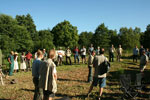 Lineup of instructors. |
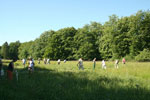 The meadows at our disposal were extensive; individual groups of students could be spread out and had room to work. |
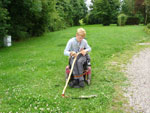
|
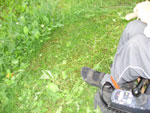
|
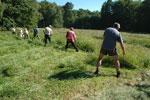 Probably a typical mowing scene in the past. In 2008 it is simply one of the few times that a group at this festival "posed" for cameras. |
Haymaking:
Photos demonstrate the traditional method of curing hay in Denmark and other parts of Scandinavia.
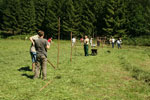 |
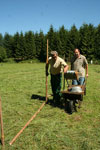
|
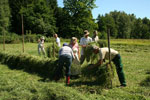
Hay drying on tensioned wires supported by posts. |
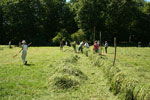 The process continues. |
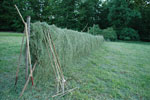 The finished row.
The finished row.
|
A great variety of other hay-curing structures have been used throughout Europe. Here are but two examples, each of which -- depending on the amount of grass/hay -- can be constructed in various sizes. The first two photos are of the tripod style, the next consist of two single "walls" leaned together. They have numerous regional names; we refer to them simply as "racks".
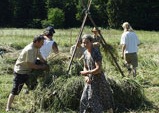 |
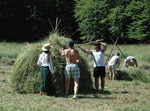 | |
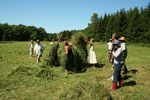 |
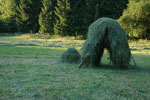
|
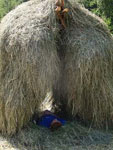
An advantage of these framed haystacks as opposed to the the Great Wired Walls of Denmark is that they can and often did provide shelter for travelers and lovers alike... |
Competitions:
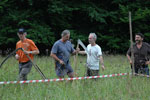 The most international team getting ready: from left: Mats Rosengren (Sweden), Raymond Lister (UK), Filip Verhaeghe (Belgium) and Simon Fairlie (UK). |
 Simon Fairlie, the man to whom contemporary U.K. mowers owe considerable thanks because, by his starting The Scythe Shop, better hand mowing equipment has been made available to them than ever before. Though there is still room for refinement in his scythe service, this down-to-earth social activist has done his best -- and in far more than just scythe matters. More power to him! |
 Raymond and Mats in good stances and energetic action. |
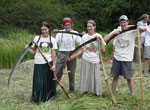 The Canadian team (Note that between them they used three distinct styles of snaths, all home made.) |
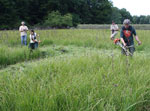 |
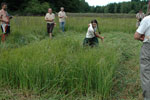 |
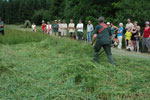 The scythe and machine in a 2.5x10 metre sprint. |
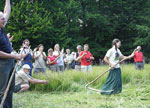 Henrik announces the winner... |
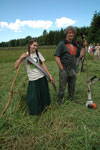 |
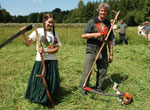 ...suggests to the man that he trades the brush saw for a scythe. |
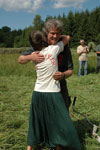 Someone humorously dubbed this shot "Beauty and the Beast", though Carsten was really a fine fellow. |
Charcoal Making:
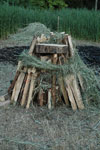 The "heart" around which the wood is piled. |
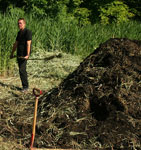 All now covered with earth, waiting for the fire. |
 Preparing the fire-making equipment. |
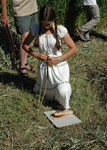 |
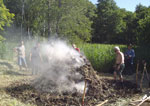 Alchemy now in progress, with hours of careful round-the-clock attendance to follow. (The amount of air entering the heap from the four directions must be carefully regulated.) |
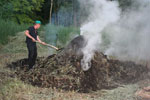 |
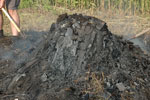 24 hours later: The blacksmith's gold is uncovered. |
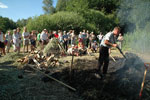 Spread to cool. |
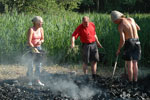 Sprinkling with water-dipped handfuls of hay. |
Lathe:
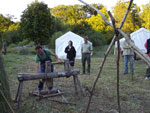 An example of primitive technology at its best. |
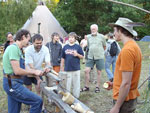 |
 |
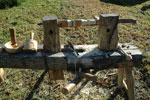 |
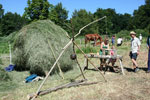 Several moms with small children were drawn to try out this practical "toy". |
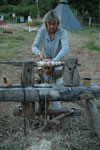 |
Snathmaking:
A few wildwood snaths were made and some commercial ones refined.
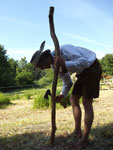 Claudio with a hatchet in one hand and piece of wood in the other, ready to make a snath. |
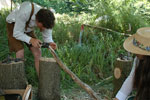 Ashley assisting in getting the angle relationships right. |
More fire pictures:
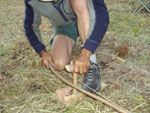 Part of of Niels Johansson, who made fire with the bow drill on his first try -- a rare feat! |
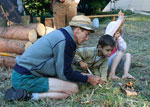 Niels and his son Julian marvel at the magic of fire. |
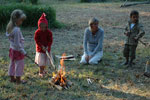 |
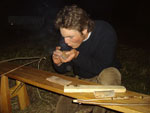 The second most successful bow drill fire maker at the festival, Claudio Horzella, a multi-talented young man the likes of which the world needs many more... |
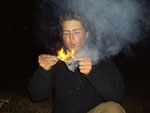 |
 |
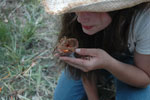 |
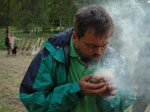 |
For some extra "evening entertainment" Ashley did another fire show. You can't see her trusting father sitting on the ground holding a candle, because the photographer focuseed on the young girl with scythe on fire. That streak of fire is a scythe blade about to cut the candle out of the man's hands.
 |
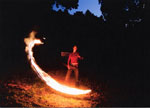 |
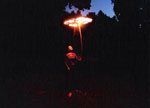 |
Then with one right- and one left-handed blade (mounted on the same snath together), she painted fire designs onto the night sky.
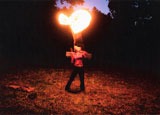 |
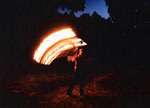 |
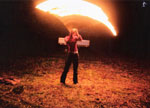 |
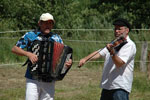 Music .... These 2 folk musicians are Stefan Groot (accordion) and Ole Nordug Jensen (fiddle). ((Ole has dedicated his life to music; specially the Old Danish folk music, and has lived from it for many years. He is working with the music in many ways)) |
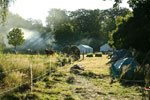 |
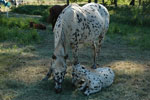 |
 |
17 Dec. 2008
Modified 23 Dec. 2008
